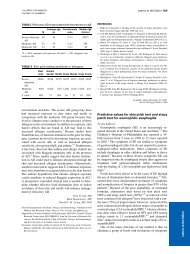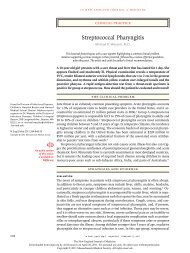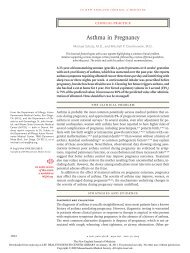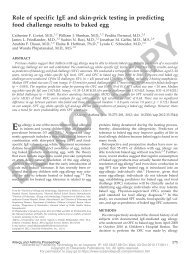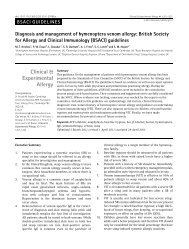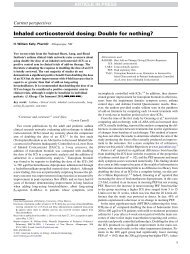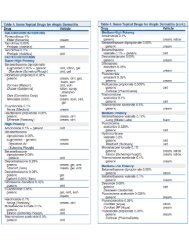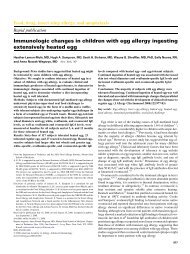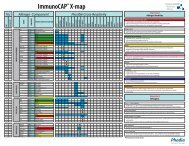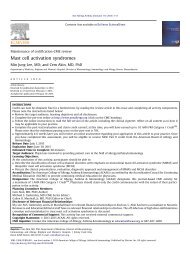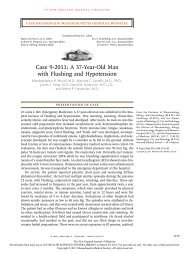CVID - Cunningham-Rundles JACI 2012.pdf - AInotes
CVID - Cunningham-Rundles JACI 2012.pdf - AInotes
CVID - Cunningham-Rundles JACI 2012.pdf - AInotes
You also want an ePaper? Increase the reach of your titles
YUMPU automatically turns print PDFs into web optimized ePapers that Google loves.
Maintenance of Certification clinical management seriesSeries editors: James T. Li, MD, PhDCommon variable immunodeficiencyCharlotte <strong>Cunningham</strong>-<strong>Rundles</strong>, MD, PhD, and Paul J. Maglione, MD, PhDNew York, NYINSTRUCTIONSCredit can now be obtained, free for a limited time, by reading the reviewarticles in this issue. Please note the instructions listed below:1. Review the target audience, learning objectives and authordisclosures.2. Complete the pre-test online at www.jacionline.org(click on the Online CME heading).3. Follow the online instructions to read the full version ofthe article, including the clinical vignette and reviewcomponents.4. Complete the post-test. At this time, you will haveearned 1.00 AMA PRA Category 1 CME Credit TM .5. Approximately 4 weeks later you will receive an onlineassessment regarding your application of this article toyour practice. Once you have completed this assessment,you will be eligible to receive 2 MOC Part II Self-Assessmentcredits from the American Board of Allergyand Immunology.Date of Original Release: May 2012. Credit may be obtained for thesecourses until April 30, 2014.Copyright Statement: Copyright Ó 2012-2014. All rights reserved.Target Audience: Physicians and researchers within the field of allergicdisease.Accreditation/Provider Statements and Credit Designation: TheAmerican Academy of Allergy, Asthma & Immunology (AAAAI) isaccredited by the Accreditation Council for Continuing Medical Education(ACCME) to provide continuing medical education for physicians.The AAAAI designates these educational activities for amaximum of 1 AMA PRA Category 1 Creditä. Physicians shouldonly claim credit commensurate with the extent of their participationin the activity.List of Design Committee Members: Charlotte <strong>Cunningham</strong>-<strong>Rundles</strong>,MD, PhD, and Paul J. Maglione, MD, PhD (authors), James T. Li, MD,PhD (series editor)Activity Objectives1. To identify the most frequent clinical presentations ofcommon variable immunodeficiency (<strong>CVID</strong>).2. To use immunoglobulin measurement and specific antibodytesting in the diagnosis of <strong>CVID</strong>.3. To understand considerations for determining properdosage of immunoglobulin replacement.4. To appreciate the effect of immunoglobulin replacementon infection susceptibility and the development ofchronic complications of <strong>CVID</strong>.Recognition of Commercial Support: This CME activity has not receivedexternal commercial support.Disclosure of Significant Relationships with Relevant CommercialCompanies/Organizations: J. T. Li has consulted for Abbott. The rest ofthe authors declare that they have no relevant conflicts of interest.CLINICAL VIGNETTEA 50-year-old woman with a history of recurrent infectionssince her early 20s presents for immunologic evaluation. After amedically uneventful childhood and teenage years, she began toexperience recurrent sinus infections in her early 20s treatedwith antibiotics and finally sinus surgery in 1990, which wassuccessful in reducing symptoms. In the next decade, she beganto note excessive fatigue and then bruising with a petechialrash. In 2000, she was given a diagnosis of immuneFrom the Division of Clinical Immunology, Department of Medicine, Mount SinaiMedical Center.Received for publication February 2, 2012; revised March 20, 2012; accepted for publicationMarch 22, 2012.Corresponding author: Charlotte <strong>Cunningham</strong>-<strong>Rundles</strong>, MD, PhD, Mount Sinai Schoolof Medicine, 1425 Madison Ave, New York, NY 10029. E-mail: charlotte.cunningham-rundles@mssm.edu.0091-6749/$36.00Ó 2012 American Academy of Allergy, Asthma & Immunologydoi:10.1016/j.jaci.2012.03.025thrombocytopenic purpura (ITP) with a platelet count of 2000.After 6 months of unsuccessful therapy with prednisone, her ITPwent into remission with a course of intravenous immunoglobulin(IVIG) only to recur in 2002. At that time, she underwentsplenectomy, which did not increase her platelet count. She wasagain treated with prednisone and IVIG, finally achievingresolution of thrombocytopenia. However, over the next 5 years,she required multiple courses of steroids to control bothrecurring sinusitis and the re-emergence of ITP. When oralsteroids could no longer relieve sinus disease, she had formalallergy testing in 2007 that was unrevealing for environmentalhypersensitivity. In the fall of 2010, she had shingles, and herchronic fatigue worsened, which she attributed to an increasinglydemanding work schedule. However, she was subsequentlyreferred for an immunologic evaluation because of hersteadily worsening clinical condition.At the time of evaluation, her complete blood count showed awhite blood cell count of 11,900 mL, a hemoglobin value of12.9 g/dL, a platelet count of 556,000 mL, a neutrophil count of1425
1426 CUNNINGHAM-RUNDLES AND MAGLIONEJ ALLERGY CLIN IMMUNOLMAY 20127770/mL, a lymphocyte count of 2650/mL, a monocyte count of1230/mL, and an eosinophil count of 150/mL. Results of routinechemistry, liver, and renal function blood testing were all withinnormal limits. A computed tomographic scan of the chest andabdomen revealed hepatic and pulmonary nodules of unclearcause. Quantitative immunoglobulin measurement revealed anIgG level of 295 mg/dL (reference range, 694-1618 mg/dL), anIgA level of 7 mg/dL (reference range, 81-463 mg/dL), and anIgM level of 44 mg/dL (reference range, 48-271 mg/dL).Urinalysis did not demonstrate proteinuria. Specific antibodytesting revealed that antibody titers did not reach protective levelsfor diphtheria, tetanus, or any of the 14 pneumococcal serotypesexamined after vaccination. Thus the patient met the formaldiagnosis of <strong>CVID</strong>.The full version of this article, including a review of relevantissues to be considered, can be found online at www.jacionline.org. If you wish to receive CME or MOC credit for the article,please see the instructions above.
J ALLERGY CLIN IMMUNOLVOLUME 129, NUMBER 5CUNNINGHAM-RUNDLES AND MAGLIONE 1426.e1DISCUSSIONOverview<strong>CVID</strong> is the most common symptomatic primary immunodeficiency,affecting an estimated 1 in 25,000 to 75,000 subjects,depending on the population examined. E1 Such values might bean underestimate because heightened physician awareness ofthe diagnosis and increased participation in primary immunodeficiencyregistries could reveal a greater incidence. Of note, althoughIgA deficiency is actually the most common primaryimmunodeficiency at an estimated frequency of 1:223 to 1:3000in the United States, most patients are asymptomatic. E2 <strong>CVID</strong> differsfrom many other primary immunodeficiencies in that it ismost frequently diagnosed in adults aged 20 to 40 years. However,about 20% of subjects are given a diagnosis before the age of 21years; although the clinical phenotype is similar for children withsignificant B-cell defects, other immune defects, such as X-linkedagammaglobulinemia or hyper-IgM syndromes, must be considered.Although more than 2000 articles on the subject can be retrievedfrom PubMed, clinical appreciation of <strong>CVID</strong> remainslimited, commonly leading to a 6- to 8-year delay in makingthis diagnosis. Lack of diagnosis delays the initiation of themost proved medical intervention, immunoglobulin replacementtherapy, a treatment that reduces bacterial infections and limitshospitalizations, as well as organ damage. E3,E4In addition to infections, patients with <strong>CVID</strong> also have apropensity to having a number of chronic complications, includingautoimmunity, chronic lung disease, inflammatory boweldisease, systemic granulomatous disease, lymphoid hyperplasia,and malignancy. E1,E5 Prevention of these complications remains amajor goal for immunologists treating patients with <strong>CVID</strong>, andmanagement remains a major challenge. The clinical case exemplifiesthe common constellation of symptoms found in such patients,including the history of ITP in this case leading tosplenectomy, shingles, and unusual radiologic findings. It also illustratesthe theme of numerous referrals to disparate specialtiesand the diagnostic delay commonly experienced.The genetic cause of <strong>CVID</strong> is most commonly unknown andmost frequently the result of a sporadic emergence in individualpatients. However, the identification of <strong>CVID</strong> familial cohorts andthe progression of some IgA-deficient patients to <strong>CVID</strong> indicate astrong contribution of genetics. E6 Polymorphisms in the costimulatorymolecules CD18, CD19, CD20, CD21, inducible costimulator,transmembrane activator and calcium-modulating andcyclophilin ligand interactor (TACI), and B cell–activating factorof the TNF family have all been linked to <strong>CVID</strong>. E7 This correlationis not surprising because B cells from patients with <strong>CVID</strong> areinhibited in their ability to develop into class-switched memoryand plasma cells, a maturation process that requires adequate costimulation.Genetic studies, including linkage analysis of familialcohorts, as well as genome-wide polymorphism associations,continue to enhance our understanding of the complex molecularmechanisms underlying <strong>CVID</strong>. E8Diagnosis and evaluationThe diagnosis of <strong>CVID</strong> is based on reduced levels of total IgG,IgA, and/or IgM and a demonstrated deficiency in specificantibody production. E1,E9 The IgG level is generally less than400 mg/dL. Deficiency of antibody production can be demonstratedby the lack of protective titers to several protein-based vaccinesand after immunization with pneumococcal vaccine.Because the diagnosis of <strong>CVID</strong> is a lifelong diagnosis, we usuallytest antibody titers to tetanus and diphtheria toxoids, Haemophilusinfluenzae, measles, mumps, rubella, varicella, and pneumococcusto validate fully the immune defect. Additionally, titers to hepatitisA or B after vaccination can also be considered, as can titersto influenza virus or isohemagglutinins, if available, and the bloodtype is known. If the quantitative serum IgG level is less than 200mg/dL, we would strongly consider initiating immunoglobulin replacement,even in an absence of functional antibody defect giventhe increased pneumonia risk in our experience. E3 In addition, forvery low serum IgG levels, one can debate the value of incurringthe expenses of obtaining multiple antibody titers when the medicaldecision to start immunoglobulin replacement therapy hasbeen made. Part of the diagnostic criteria of <strong>CVID</strong> includes excludingother diagnoses that might lead to hypogammaglobulinemia.This comprises other genetic diseases, immunoglobulin lossin urine or stool, use of medications, and malignancy.Chronic oral corticosteroid use can lead to reduced IgGlevels E10 ; in the case outlined here, the patient had not receivedsuch therapy for some months. The mechanism of IgG suppressionis unclear but might be due at least in part tocorticosteroid-induced catabolism of IgG, suppression of leukocyteresponses that promote IgG secretion, or both. Interestingly,the effect appears to be most potent for IgG, and IgE levels do notseem to be similarly suppressed in studies of allergic patients takingchronic oral corticosteroids. Conventional low doses (5 mg) oforal corticosteroids do not typically decrease IgG levels, althoughthere is a reported case of hypogammaglobulinemia in a patientwho was receiving low-dose corticosteroid therapy for 36years. E11 Hypogammaglobulinemia associated with extendedcourses of high-dose steroids has been reversed by corticosteroidabstinence in our experience.Other medications linked to suppression of antibody responsesinclude antirheumatic agents, such as azathioprine, cyclophosphamideD-penicillamine, gold, and sulfasalazine. E12 Additionally,anticonvulsants, such as carbamazepine, levetiracetam,oxcarbazepine, and phenytoin, have all been associated with selectiveisotype deficiency or losses among all isotypes. E13-E16 The exactmechanism by which anticonvulsants inhibit IgG responses isunknown and can require months to years of medication avoidanceto return to normalized immunoglobulin levels. E14,E15 The mostcommon medications associated with hypogammaglobulinemiaare listed in Table E1, E12-E16 along with relevant citations.Abnormal radiologic findings of nodules in the liver and lung,such as seen in our example patient, are indicative of granulomatousdisease that is found in 8% to 22% of patients with <strong>CVID</strong>. E17Such findings often lead to diagnostic delay, such as can happenwhen pulmonary nodules are attributed to sarcoidosis ratherthan unappreciated <strong>CVID</strong>. Moreover, the presence of granulomatousdisease might indicate the necessity for immunosuppressanttreatment. E18 Of note, a history of shingles is not uncommonin patients with <strong>CVID</strong> and might be due to reported deficienciesin T-cell responsiveness in at least subsets of these patients. E19ManagementThe standard of treatment for <strong>CVID</strong> is 400 to 600 mg/kg ofimmunoglobulin replacement therapy administered either intravenously,generally every 3 to 4 weeks, or as subcutaneousimmunoglobulin, most commonly every 1 to 2 weeks. The routeof immunoglobulin replacement therapy is best determined bypatient preference, as well as clinical considerations of thepatient. Commercially available immunoglobulin preparations
1426.e2 CUNNINGHAM-RUNDLES AND MAGLIONEJ ALLERGY CLIN IMMUNOLMAY 2012vary in composition, each having an additive, such as an aminoacid, sorbitol, salt, or sugar, to prevent protein aggregations.These can influence the selection of a preparation for an individualpatient. Although there is one product very low in IgA that hasbeen used in subjects with anti-IgA antibodies, testing for anti-IgA antibodies is not generally done before starting immunoglobulinreplacement because of the rarity of clinically importantantibodies of this kind.The dosage of immunoglobulin for intravenous use is evaluatedby measuring trough IgG levels drawn before administration.Although an earlier goal of immunoglobulin replacement wasconsidered to be a trough serum value of around 600 mg/mL, E20 anumber of recent studies suggest that higher, even individualized,dosages might be beneficial. E21 For subcutaneous delivery, a sampledrawn just before a treatment can provide this value. Althoughtrough levels of 1000 mg/dL correlated with a 5-fold decrease inpneumonia when compared with patients at 500 mg/dL in onemeta-analysis, E21 comprehensive reduction in the incidence ofmultiple infections is not always associated with higher troughvalues. E22 Contributing to the inherent complexity of dosingIgG replacement are the physiologic differences among patientsrelating to immunoglobulin production and metabolism, makingthe extrapolation of a single goal IgG trough for all patients inappropriate.Goal IgG troughs are dictated by the baseline serumIgG level, as well as the extent of functional antibody responses. E5Accordingly, a goal trough IgG level should be determined basedon the preintervention baseline: a patient with profoundly compromisedIgG levels might see noted clinical benefit from agoal trough of 600 mg/dL of IgG, whereas a patient with slightlybelow-normal IgG levels yet profoundly compromised specificantibody responses might need a significantly higher trough levelto achieve clinical benefit. In other words, immunoglobulinreplacement should be individualized, with dose adjustment consideredbased on clinical course. Moreover, physiologic determinants,such as neonatal Fc receptor expression, might affect thehalf-life of immunoglobulin, consequently requiring higher dosesto achieve clinical response in certain patients. E23 The neonatal Fcreceptor is a broadly expressed MHC class I–like molecule thatfunctions to increase IgG half-life through protection from catabolism.E24 Once established on immunoglobulin replacement therapy,IgG trough levels are measured every 6 to 12 months toensure adequate dosing and administration.THE CASE REVISITEDFinally, a consulting hematologist who saw this patient in 2011decided to refer her for immune deficiency evaluation based onher history of recurrent sinusitis, shingles, hepatic and pulmonarynodules, and ITP. The serum immunoglobulins were examined,and antibody defects were documented. On the basis of thediagnosis of <strong>CVID</strong>, she was started on 400 mg/kg IVIG once amonth. The primary goal of this therapy will be to reduce theincidence of sinus infections and reduced use of antibiotics andcorticosteroids. Although episodes of ITP are reduced in patientswith <strong>CVID</strong> who have had recurrent bouts of thrombocytopenia,E25 pulmonary nodules are not likely to be altered by this therapy,as for most of the other noninfectious complications of<strong>CVID</strong>. E1,E26REFERENCESE1. Chapel H, <strong>Cunningham</strong>-<strong>Rundles</strong> C. Update in understanding common variable immunodeficiencydisorders (<strong>CVID</strong>s) and the management of patients with theseconditions. Br J Haematol 2009;145:709-27.E2. Yel L. Selective IgA deficiency. J Clin Immunol 2010;30:10-6.E3. Busse PJ, Razvi S, <strong>Cunningham</strong>-<strong>Rundles</strong> C. Efficacy of intravenous immunoglobulinin the prevention of pneumonia in patients with common variable immunodeficiency.J Allergy Clin Immunol 2002;109:1001-4.E4. Pourpak Z, Aghamohammadi A, Sedighipour L, Farhoudi A, Movahedi M, GharagozlouM, et al. Effect of regular intravenous immunoglobulin therapy on preventionof pneumonia in patients with common variable immunodeficiency.J Microbiol Immunol Infect 2006;39:114-20.E5. <strong>Cunningham</strong>-<strong>Rundles</strong> C. How I treat common variable immune deficiency. Blood2010;116:7-15.E6. Espanol T, Catala M, Hernandez M, Caragol I, Bertran JM. Development of a commonvariable immunodeficiency in IgA-deficient patients. Clin Immunol Immunopathol1996;80:333-5.E7. van de Ven AA, Compeer EB, van Montfrans JM, Boes M. B-cell defects in commonvariable immunodeficiency: BCR signaling, protein clustering and hardwiredgene mutations. Crit Rev Immunol 2011;31:85-98.E8. Park JH, Resnick ES, <strong>Cunningham</strong>-<strong>Rundles</strong> C. Perspectives on common variableimmune deficiency. Ann N Y Acad Sci 2012;1246:41-9.E9. Notarangelo LD, Fischer A, Geha RS, Casanova JL, Chapel H, Conley ME, et al.Primary immunodeficiencies: 2009 update. J Allergy Clin Immunol 2009;124:1161-78.E10. Lack G, Ochs HD, Gelfand EW. Humoral immunity in steroid-dependent childrenwith asthma and hypogammaglobulinemia. J Pediatr 1996;129:898-903.E11. Fedor ME, Rubinstein A. Effects of long-term low-dose corticosteroid therapy onhumoral immunity. Ann Allergy Asthma Immunol 2006;97:113-6.E12. Lee AH, Levinson AI, Schumacher HR Jr. Hypogammaglobulinemia and rheumaticdisease. Semin Arthritis Rheum 1993;22:252-64.E13. Hayman G, Bansal A. Antibody deficiency associated with carbamazepine. BMJ2002;325:1213.E14. Azar AE, Ballas ZK. Reversible panhypogammaglobulinemia associated with theantiepileptic agent levetiracetam. Ann Allergy Asthma Immunol 2008;101:108-9.E15. Knight AK, <strong>Cunningham</strong>-<strong>Rundles</strong> C. Oxcarbazepine-induced immunoglobulindeficiency. Clin Diagn Lab Immunol 2005;12:560-1.E16. Pereira LF, Sanchez JF. Reversible panhypogammaglobulinemia associated withphenytoin treatment. Scand J Infect Dis 2002;34:785-7.E17. Ardeniz O, <strong>Cunningham</strong>-<strong>Rundles</strong> C. Granulomatous disease in common variableimmunodeficiency. Clin Immunol 2009;133:198-207.E18. Yong PF, Thaventhiran JE, Grimbacher B. ‘‘A rose is a rose is a rose,’’ but <strong>CVID</strong>is Not <strong>CVID</strong> common variable immune deficiency (<strong>CVID</strong>), what do we know in2011? Adv Immunol 2011;111:47-107.E19. <strong>Cunningham</strong>-<strong>Rundles</strong> C, Bodian C. Common variable immunodeficiency:clinical and immunological features of 248 patients. Clin Immunol 1999;92:34-48.E20. Orange JS, Hossny EM, Weiler CR, Ballow M, Berger M, Bonilla FA, et al. Useof intravenous immunoglobulin in human disease: a review of evidence by membersof the Primary Immunodeficiency Committee of the American Academy ofAllergy, Asthma and Immunology. J Allergy Clin Immunol 2006;117(suppl):S525-53.E21. Orange JS, Grossman WJ, Navickis RJ, Wilkes MM. Impact of trough IgG onpneumonia incidence in primary immunodeficiency: a meta-analysis of clinicalstudies. Clin Immunol 2010;137:21-30.E22. Lucas M, Lee M, Lortan J, Lopez-Granados E, Misbah S, Chapel H. Infectionoutcomes in patients with common variable immunodeficiency disorders: relationshipto immunoglobulin therapy over 22 years. J Allergy Clin Immunol2010;125:1354-60, e4.E23. Sachs UJ, Socher I, Braeunlich CG, Kroll H, Bein G, Santoso S. A variable numberof tandem repeats polymorphism influences the transcriptional activity of theneonatal Fc receptor alpha-chain promoter. Immunology 2006;119:83-9.E24. Kuo TT, Baker K, Yoshida M, Qiao SW, Aveson VG, Lencer WI, et al. NeonatalFc receptor: from immunity to therapeutics. J Clin Immunol 2010;30:777-89.E25. Wang J, <strong>Cunningham</strong>-<strong>Rundles</strong> C. Treatment and outcome of autoimmune hematologicdisease in common variable immunodeficiency (<strong>CVID</strong>). J Autoimmun2005;25:57-62.E26. Malamut G, Verkarre V, Suarez F, Viallard JF, Lascaux AS, Cosnes J, et al. Theenteropathy associated with common variable immunodeficiency: the delineatedfrontiers with celiac disease. Am J Gastroenterol 2010;105:2262-75.
J ALLERGY CLIN IMMUNOLVOLUME 129, NUMBER 5CUNNINGHAM-RUNDLES AND MAGLIONE 1426.e3TABLE E1. Medications associated withhypogammaglobulinemiaMedicationAzathioprineCyclosporineD-penicillamineGoldSulfasalazineCarbamazepineLevetiracetamOxcarbazepinePhenytoinReferenceLee et al E12Lee et al E12Lee et al E12Lee et al E12Lee et al E12Hayman and Bansal E13Azar and Ballas E14Knight and <strong>Cunningham</strong>-<strong>Rundles</strong> E15Pereira and Sanchez E16



